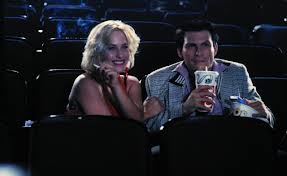If you peruse the internet and read the oodles of articles that have been written on this film, you will mostly find that people are either saying it's the best horror movie of the year or they are saying that it's terrible. I'm somewhere in the middle of the debate. It's true that the "found footage" horror movie premise has long outworn its welcome and it is still incredibly baffling that it still makes anyone filthy rich. Most recently The Devil Inside (2012) which cost one million dollars to make, made 100 million at the box office. Its profits multiplied its budget by one hundred times! I guess Hollywood found a cheap formula that works. The Paranormal Activity trilogy also proved that people still want to see that crap, even if they've already seen it before and afterward will just talk about how awful it was. I guess negative publicity is still publicity, and most of these people want to see it for themselves. Which is actually a good thing. Critics serve a purpose, I truly believe that. But I also think most people can tell from a trailer if it's going to be the kind of thing they want to see or not. This is why I am always amazed by whenever I go to the theatre and someone always walks out in the first few minutes. I just shake my head and say to myself, "Really? Did you actually think this was going to be your kind of movie?"
So we've established that V/H/S is a "found footage" film, but it does something clever and combines that with another sub-genre of horror- the anthology. Horror anthologies go back to the 1920's, but they started to get more popular in the 50's. They are essentially several short films tied together with a frame story. Television series like The Twilight Zone, Night Gallery and Amazing Stories are the kind of tales you usually find in an anthology film. And many of them are directly influenced by horror comics and pulp magazines. My favorite horror movie so far this century is an anthology film- Trick 'r Treat (2007). It was much more of a throwback to the older anthology films which always had a distinct visual style, whereas V/H/S really cranks up the terror and reinvents the sub-genre. Its five segments are also directed by five different directors.
The frame story of V/H/S involves a group of guys who make a living by going around with a video camera and assaulting young women and recording the act. They say that they get 50 bucks a tape. This sets up the film the way too many horror films are set up- with the viewer hating the protagonist. The reason these guys are the protagonists is because they're the ones being tormented in the film. The film is not about their attacks on women. So when the torment comes, there is very little sympathy. These guys get a job breaking into a house to steal a tape. In the house they start going through a stack of tapes and view the five segments that make up the anthology.
Even though the five segments are directed by different directors, they fit together well and the whole thing is very cohesive. But some of the segments work better than others. The first is incredibly strong and has some intensely startling visuals. It also has some amazing casting on the part of a young dark haired succubus with haunted eyes. But again, the males are all unlikeable and overblown with stereotypically macho personalities.
A clever segment is made entirely with a recorded conversation using web cams via a Skype like service. One problem with this one, is that there are several times where one of the characters asks if he was recording at that moment and he says he wasn't. So how we got to see the entire interaction, we'll never know. V/H/S does that a few other times too. We see things that would not have been caught on tape, but for the purpose of putting together a complete story, they had to throw it in somewhere. Much of the material is so strong and so entertaining, that this flaw can easily be forgiven.
One other complaint I have about the film is its length. I read a suggestion somewhere that I absolutely agree with, saying that they could have taken one of the stories out and made it shorter. Second Honeymoon or Tuesday the 17th would not be missed if either had been saved as a DVD extra. But other than that, the movie is pretty strong. Much of it is actually scary and almost the whole thing is a lot of fun. And for me, that is the most important element of a good horror film.



























